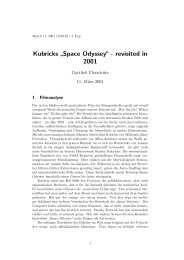Henry M. Taylor, 'Frames, Cons, and Double-Crosses - Cinetext
Henry M. Taylor, 'Frames, Cons, and Double-Crosses - Cinetext
Henry M. Taylor, 'Frames, Cons, and Double-Crosses - Cinetext
Create successful ePaper yourself
Turn your PDF publications into a flip-book with our unique Google optimized e-Paper software.
Little surprise, then, that Mamet's first <strong>and</strong> critically acclaimed directorial effort should have<br />
been the stylized neo-noir thriller HOUSE OF GAMES, which also established the paradigmatic te-<br />
nets of his subsequent film work. Focalized almost exclusively through the point of view of the<br />
female protagonist as amateur sleuth, Dr. Margaret Ford (Lindsay Crouse) is a prosperous, ambi-<br />
tious, <strong>and</strong> overworked psychoanalyst who has has made a name for herself with a newly-<br />
published self-help book on obsessive behaviour. She is introduced to us immediately in the first<br />
scene, a daytime exterior setting amid what appear to be office buildings, as a young woman in a<br />
startlingly red dress, holding a copy of the bestseller <strong>and</strong> as compulsive as the book's title Driven,<br />
approaches her for an autograph. Mamet's straight-shooting, slightly stilted dialogue <strong>and</strong> the slick<br />
aloofness of the main character (wearing sunglasses) already become evident in this exchange:<br />
[The young woman:] – Are you Doctor Margaret Ford?<br />
— Yes.<br />
– Could I ask you, would you sign my book?<br />
— Yes, of course.<br />
– I recognised you from your picture. I hope I'm not inconveniencing you.<br />
— Not at all.<br />
– It's for a friend. It's the second one I bought.<br />
— Then I'm doubly pleased. [Beat.] Thank you for buying it.<br />
– You've helped me very much.<br />
— [Steadfastly looking at the young woman:] I'm very glad I have. [Beat.] Thank you. [Beat.] Goodbye. [Turns<br />
<strong>and</strong> walks away.]<br />
The overemphasized pauses (beats), lasting just a bit too long, <strong>and</strong> the protagonist's intentionality,<br />
her long, immobile <strong>and</strong> intent, but expressionless look at the other woman at the end of the brief<br />
exchange, lend the interaction a formalist theatrical effect, ever so slightly pointing to the gap be-<br />
tween the body of the performer <strong>and</strong> her fictional character. The effect is underscored by the as-<br />
cetic camera work, beginning the scene with a tracking shot from a wall to the woman holding a<br />
copy of the book in her h<strong>and</strong>s, in an allegorical expression of the title Driven. The following<br />
shots have an insistent character, as though the static camera were staring at Dr. Ford, <strong>and</strong> wait-<br />
ing for something to happen. In effect, the camera operates just like Mamet's short main clauses,<br />
within a system of pure functionality in which everything has a purpose, an intent.<br />
9



